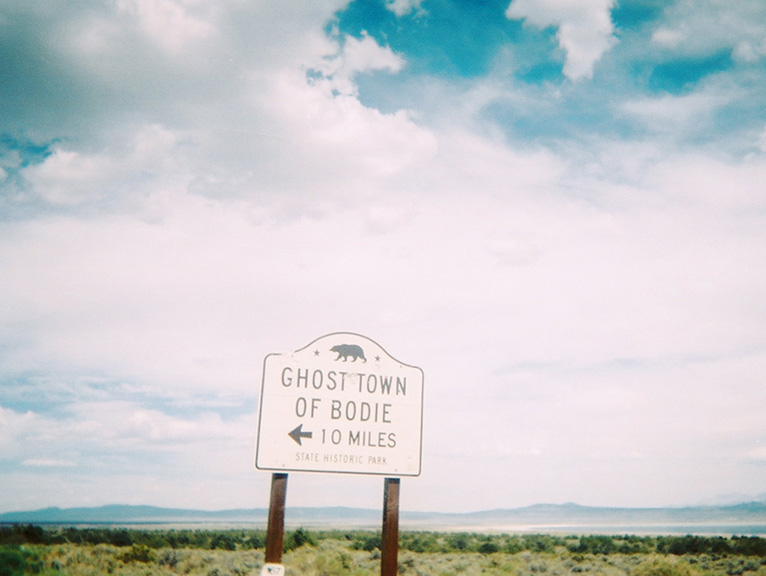A Gold Rush ghost town embalms the risks that haunt all California settlements.
Bodie, California, is a cluster of nearly a hundred houses, churches, and saloons on the eastern slope of the Sierras, less than ten miles from the Nevada border. It’s more of a museum than a town—it’s been a historic park and a tourist destination since 1962, when the state of California salvaged it from terminal decline. Bodie has since remained in a condition of “arrested decay,” meaning that it’s prevented from disintegrating but no further development is allowed. It’s effectively frozen in time, progress and deterioration both prohibited by law.
The Sierra Nevada peaks stand like a partition between Bodie and the rest of California—its fertile Central valley, its foggy Northern coastline, its palm trees and Joshua trees and redwoods. California’s legendary health-giving climes are alien to Bodie, which experiences bone-dry summers and long, morbid winters. The town site, which is perched at a staggering 8,400 feet, thirsts without relief and never sees a month without below-freezing temperatures, rivaling Barrow, Alaska, for the coldest nights in the U.S. The landscape is nearly treeless, covered in a coarse mantle of sage shrubs and spiny grasses. Bodie exists in a no-man’s land between a recognizably Californian biome and the immense dead-zone of the Great Basin, an abyss of iridescent flats and lunar crags that extends through Nevada and Utah. The town seems to belong more to the latter landscape, one characterized by monotony and desolation and a supernatural quiet, than to California’s sea foam and citrus groves, its shopping plazas and its tangle of highways and interstates.
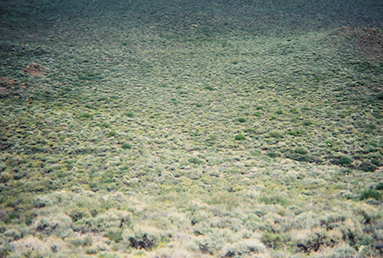
A Gold Rush-era mining town, Bodie was swiftly populated in the late 19th century and just as swiftly abandoned in the early 20th century, leaving behind a husk of a city. The town boasted 10,000 residents in 1880, and zero by the 1940s, after the mines had dried up and a town-wide fire had expelled the remaining holdouts. The vacant outpost was simply left to decompose in the sun and snow—that is, before the state took an official interest. Now, hundreds of thousands of visitors come to Bodie every year to wander the streets on guided tours and peer into the site’s dilapidated houses and storefronts. The buildings’ interiors boast pots and pans, cans and bottles, iron bed frames, tattered curtains, faded wallpaper, shredded hymnals. There are dusty coffins in the undertaker’s studio and a half-finished billiards game in the saloon. Sightseers toss coins through an open window into a small bowl behind a weathered church pew.
Visitors are not allowed inside the buildings. Many windows are paned with glass, the doors bolted, and the half-crumbled edifices fitted with alarms tucked into rotted roof beams. The on-site maintenance crew regularly does work on the buildings so that they don’t fall down, but they aim to keep the site visually identical to when it was incorporated as a park. The buildings that lean are kept precisely leaning, suspended between the opposing forces of restoration and obliteration.
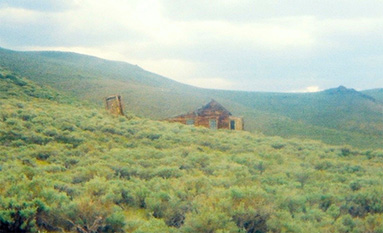
The surrounding region is dotted with settlements that are also called ghost towns, including some that are still sparsely inhabited and some that endure only as a few collapsed mine shafts and foundations overgrown with brambles. But Bodie is different. It is California’s official ghost town, the jewel in the crown, a testament in amber to a cherished past.
In his classic California: A History, Kevin Starr wrote, “In just about every way possible—its internationalism, its psychology of expectation, its artistic and literary culture, its racism, its heedless damage to the environment, its rapid creation of a political, economic, and technological infrastructure—the Gold Rush established, for better or for worse, the founding patterns, the DNA code, of American California.” If the Gold Rush provided the blueprint for majoritarian California consciousness, then Bodie State Historical Park is that consciousness doubling back to examine its own origins. The examination is far from impartial.
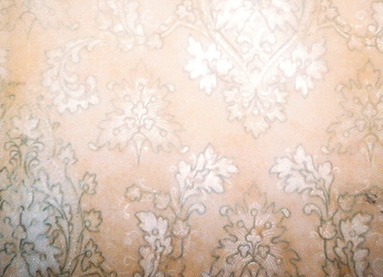
The interpretation of history that undergirds the whole project of contemporary Bodie is blind to the more toxic elements of Gold Rush history. Take its racism: As Starr explains, Mexicans who endeavored to strike it rich—many of whom had been citizens of California under Mexican rule—were frequently fined, beaten or lynched. Meanwhile “the miners cleared the goldfields of Native Americans through wholesale slaughter, [and] restricted the Chinese to abandoned diggings.” At one time, Bodie boasted the second largest Chinatown in California outside of San Francisco, populous enough to merit a Taoist temple. Today all that’s left of it is an opium pipe, a lantern and a few other sundries in a glass display case located adjacent to the park’s gift shop. The Chinese buildings eroded before the 1962 incorporation, located as they were in a separate enclave further up the forbidding slopes, where they were more exposed to the punitive elements.
In the gift shop, you can browse books and pamphlets that reconstruct and celebrate the lives of the town’s majority demographic—single white American men, hard workers and heavy drinkers with individual moral codes that didn’t always correspond to the law. The back of one book reads, “Most of Bodie’s population consisted of mining camp men—virile, enthusiastic and free-living. They were bound by few of the rules of conventional society, though they had an admirable code of their own: liberal-minded, square-dealing, generous, and devoid of pretense or hypocrisy. These men gave Bodie its distinctive flavor.” The story told here is a standard settler fairytale, in which it takes wild but noble men to tame a wild and formidable land. These were the same men—generous and admirable—who organized a racist mob to attack Chinese laborers in a nearby railroad camp in 1881.

Around the time that Bodie’s mines began to run dry, the California coast (particularly the southern portion) began gaining a reputation as a nourishing paradise for wealthier white Americans from the East. “The ignorant, hopelessly un-American type of foreigner which infests and largely controls Eastern cities is almost unknown here,” wrote one enthusiast in 1895, referring implicitly to Jews and Italians and Eastern Europeans in cities like New York and Chicago. These effete foreign urbanites of the racist imaginary were contrasted to the “virile” white archetypes of the Forty-niner and Anglo cattle rancher, who had done the heavy lifting and prepared California for the white American multitude. In the late nineteenth century, California was billed, Starr notes in his book Inventing the Dream, as “the new Eden of the Saxon home-seeker.” Its soil was fertile, it weather was fine, and it was marketed as a racial tabula rasa, wrested from Native Americans and mestizos and uncontaminated by troublesome non-white immigrant communities (black and East Asian people, for their part, were mostly concentrated in heavily segregated coastal cities).
The working class men at mining camps like Bodie had acted as forerunners for white middle-class settlement of California, clearing the way for the less hardy bourgeoisie back East. The next wave of settlers fell in love with the persona of the Forty-niner, celebrating him in art and literature and classrooms and museums. Symbolically, he functioned as an assurance that the California frontier was suffered by adventurous Anglo-Saxon settlers for the benefit of their racial brethren. White Californians of the early 20th century could turn to the Forty-niner for proof, however biased or insubstantial, that they really did belong in this strange colony at the edge of the continent.
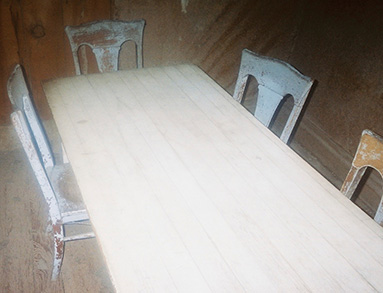
The sliver of history favored by Anglo-Californians is, from another perspective, monstrous. “Miners came to grab and get out,” writes Rebecca Solnit in Storming the Gates of Paradise, “and they laid waste to their surroundings with gleeful abandon.” The Gold Rush was a disaster for the land itself: Mining corporations polluted California’s water supply with mercury, used in huge quantities to extract gold ore. Solnit estimates that 7,600 tons of mercury seeped into California’s rivers, streams, lakes, even the San Francisco Bay, and mercury sticks around. “The Gold Rush is still poisoning the Golden State,” she writes.
Forests were clear-cut to feed gold smelters. Bears and wolves were driven out by the absence of tree-cover, or the toxic water, or the poisoned fish, or else they were gunned down by settlers for food or sport. The land’s undoing had fatal consequences for its numerous native communities, who still held legal rights to most of the areas in which gold was mined. “The indigenous inhabitants were displaced and slaughtered,” Solnit explains, “and the native food sources—fish, game, and piñon pines—were devastated,” so that even the displaced found themselves yearning for a world that was long gone.
As a talisman for the Golden State, Bodie allows white Californians to do just the opposite, providing a blinkered and comforting view of a complex history. California is a world apart: It has historically been separated from the rest of inhabited America by searing desert, staggering mountains, and the vast Great Basin, while to its west lies the vaster Pacific Ocean. Californians are also famously disconnected from history—with relatively few buildings, institutions and communities existing in the region for more than a century, California seems to suffer from a scarcity of heritage, a paucity of collective narrative or purpose. But Bodie fixes and centralizes Anglo settler culture in the historical narrative, giving white Californians a sense of legacy and belonging, which has traditionally been hard to locate.
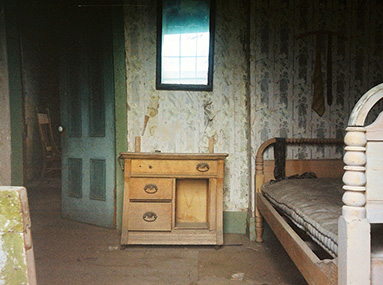
All settler cultures compose flattering histories to ease the uncertainty and solitude of life on strange, stolen land. They replace alienation with jingoistic conviction—in this case, the conviction that for Anglo-American overland settlers, California corresponds to a modern conception of historia humana in which fortunes are made or seized, rather than divinely gifted. California is a land not so much promised as hard-won, the story goes, a reward for the risk and labor undertaken by white pioneers from the American East. California was endured and earned; it has been bought and paid for; it thus rightly belongs to its current owners, who belong nowhere else.
Bodie also performs a second function, one related to its peculiar temporal suspension and arrested decay. In an essay titled “Imperial Ruin Gazers, or Why did Scipio Weep?” the theorist Julia Hell introduces the concept of the “ruin gaze” to describe how people engage with architectural vestiges of past civilizations. A sense of dramatic elegy typically pervades the ruin gaze, whether its object is Machu Picchu or an abandoned neighborhood house. Onlookers theoretically feel somber astonishment at the scope of power, the folly of empire; it is possible to experience a heightened understanding of the rise and fall of cultures, the depredations of time.
But as Hell explains, empire has long interfered with or sought to control the ruin gaze, strategized to mobilize it against the specter of imperial decline. In Bodie, the state of California proudly maintains a ruin not of a past civilization but of its own, and displays it in a way that emphasizes rise over fall, celebrating the formation of empire without consideration of the havoc it wreaked or the legacy of inequality left in its wake—or, indeed, the damage to come.
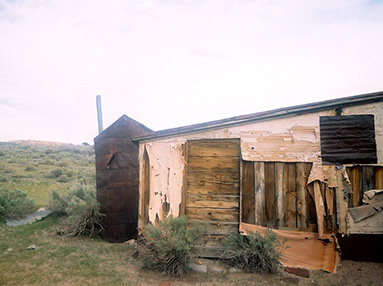
No empire lasts forever. Often the very values that propel its ascension—in this case a “grab and get out” capitalist mentality—prove untenable and result in either spectacular collapse or painful, pitiful deterioration. By freeze-framing the Forty-niner in his moment of glory, Bodie endorses an ill-fated ideology based on rapid, reckless growth and obscures the costs thereof, both in the past and in the future. As Kevin Starr’s claim of Gold Rush DNA suggests, the state’s development pattern is helplessly characterized by booms and busts, rapid development and sloppy abandonment, influxes of capital running parallel to a trail of destruction. This phenomenon is by no means exclusive to California, but modern California is almost exclusively its result.
Bodie is kept old-looking enough to inspire wistful nostalgia, but not left to corrode and rot like the residue of capitalist intemperance it is. If it were, it might invite a more critical ruin gaze, one that sees the rise and fall of colonial settlements, the bust that follows each boom, the damage of every dollar. Freezing Bodie in time denies a potentially unsettling knowledge of the current order’s instability, replacing it with the promise of both a proud past and a bright future for American California.
Since their arrival, American Californians have always been, according to Mark Twain, “getting up astounding enterprises and rushing them through with a magnificent dash and daring and a recklessness of cost or consequences.” Bodie is a commendation of California’s unique capacity for capitalist development and wreckage, its location not just at the edge of the continent but also the edge of the present moment, facing a golden horizon. In this strange embalmed city, California finds a sense of belonging in the past, and attempts to ward off an uncertain future, too.
